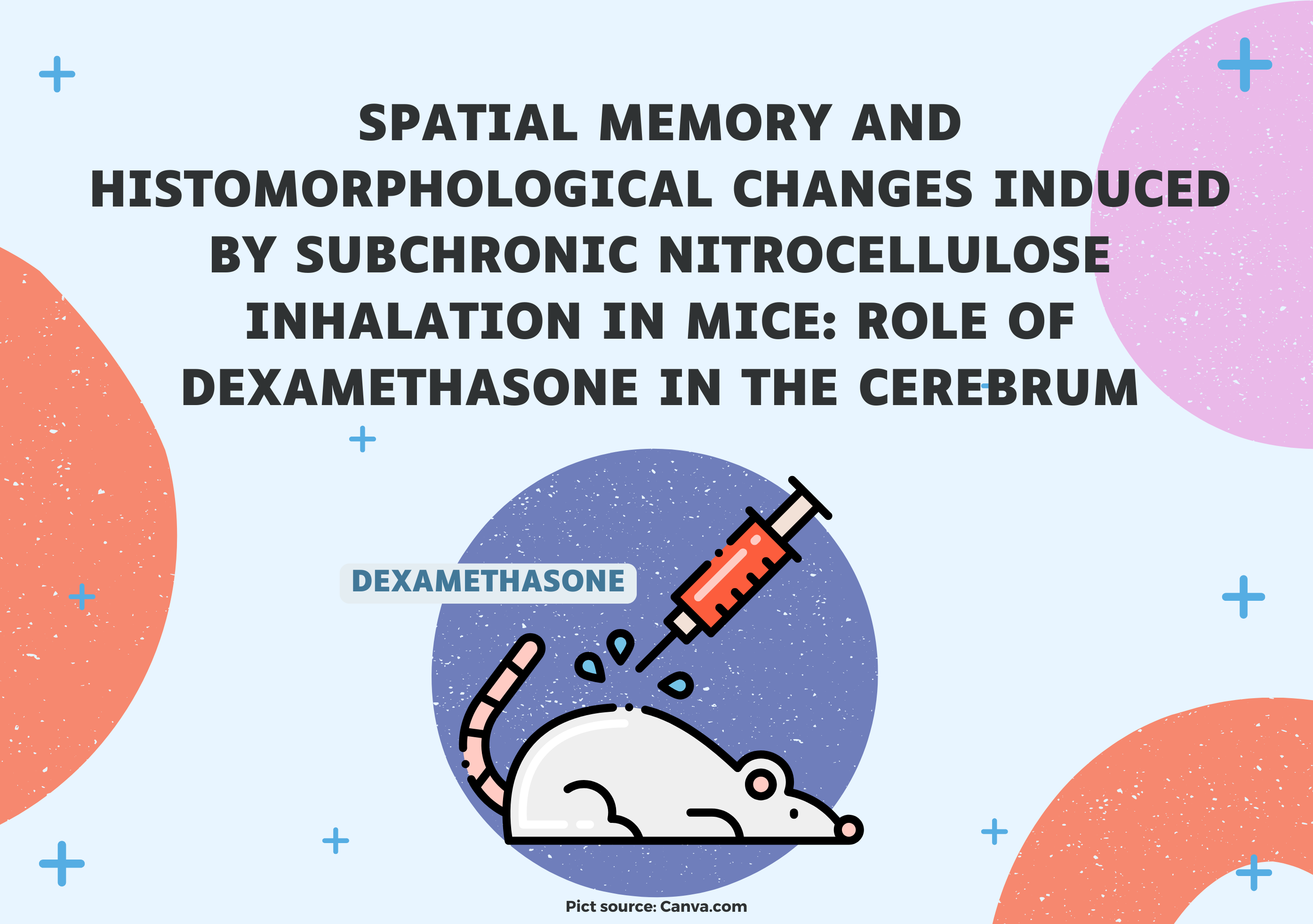SPATIAL MEMORY AND HISTOMORPHOLOGICAL CHANGES INDUCED BY SUBCHRONIC NITROCELLULOSE INHALATION IN MICE: ROLE OF DEXAMETHASONE IN THE CEREBRUM

Downloads
Introduction: Thinners are toxic substances used as organic solvents. Adolescents (11%) use thinners as inhalants regularly, which is linked to brain damage and learning deficits. This study looked at the effects of thinner inhalation in adult male mice and dexamethasone's anti-inflammatory effects on pyramidal neurons and glia. Aim: To investigate dexamethasone's anti-inflammatory effects on nitrocellulose inhalation. Methods: Forty mice were used; group one served as a control; group two was exposed to 1200ppm nitrocellulose in a whole-body inhalation chamber for 42 days; group three was injected with 2.5mg/kg dexamethasone twice weekly; and group four received nitrocellulose inhalation daily and dexamethasone twice weekly. Neurobehavioral study for learning and memory was conducted before sacrifice. Brains were harvested and processed for histology and biochemical activities of MDA and IL-6. Analysis of data was done using Graphpad Prism 8.4.3 with level of significance at P<0.05. Results: Indices of learning and memory in the nitrocellulose group were reduced escape latency and duration spent in the quadrant but not in the control or dexamethasone group (P=0.009). The MDA and IL-6 levels were higher in the nitrocellulose group compared to control and dexamethasone groups (P=0.02; P=0.03, respectively). Density of pyramidal neurons in layer 5 and 6 was significantly lower in the nitrocellulose treated groups compared to control and dexamethasone (P<0.0001). Conclusion: Dexamethasone reduced neuronal and glial cell damages in the pre-frontal cortex, accompanied with spatial learning and memory improvement.
Agency for Toxic Substances and Disease Registry (ATSDR). (2000). Toxicological profile for toluene. U.S. Public Health Service, U.S. Department of Health and Human Services, Atlanta, GA.
Agin, K., Hassanian-Moghaddam, H., Shadnia, S., Rahimi, H.R. (2016). Characteristic manifestations of acute paint thinner-intoxicated children. Environ. Toxicol. Pharmacol 45, pp 15-19. doi: https://doi.org/10.1016/j.etap.2016.05.001
Ajiboye, E.O., Olopade, F.E., Femi-Akinlosotu, O.M., Shokunbi, M.T. (2024). Recovery of learning and memory deficits despite persistence of pyknosis in the hippocampal pyramidal neurons of adult hydrocephalic mice. J. West African College of Surg. (In Press) https:// doi:10.4103/jwas.jwas_118_23
Baydas, G., Ozvern, F., Akdemir, I., Tuzcu, M., Yasar, A. (2005a). Learning and memory deficits in rats induced by chronic thinner exposure are reversed by melatonin. J. Pineal Res 39 pp 50-56. doi: https://doi:10.1111/j.1600-079X.2005.00212.x .PMID:15978057
Baydas, G., Ozvern,, F., Akdemir, I., Tuzcu, M., Yasar, A. (2005b). Effects of thinner exposure on the expression pattern of neural cell adhesion molecules, level of lipid peroxidation in the brain and cognitive function in rats. Eur. J. Pharmacol. 512 pp 181-187. doi: https://doi:10.1016/j.ejphar.2005.02.038. PMID:15840403
Beckley, J.T., Woodward, J.J. (2013) Volatile solvents as drugs of abuse: focus on the cortico-mesolimbic circuitry. Neuropsychopharmacology. 38(13) pp 2555-67. doi: https://doi:10.1038/npp.2013.206 PMID: 23954847
Bowen, S.E. and Cruz, S.L. (2012) “Inhalant addiction and toxic effects in the human”, in the effects of drug abuse on the human nervous system, eds B. Madras and M. Kuhar (Milan: Springer), pp 553-574 https://doi.org/10.1016/B978-0-12-418679-8-00018-6
Bowen, S.E., Wiley, J.L and Balster (1996). The effects of abused inhalants on mouse behaviour in an elevated plus-maze. Eur. J. Pharmacol. 312:131-136 https://doi.org/10.1016/0014-2999(96)00459-1
Cruz, S.L., Mirshahi, T., Thomas, B., Balster, R.L., Woodward, J.J. (1998). Effects of the abused solvent toluene on recombinant N-methyl-D-aspartate and non-N-methyl-D-aspartate receptors expressed in Xenopus oocytes. J. Pharmacol. Exp. Ther. 286(1), pp 334-340 PMID:9655877
Cruz, S.L., Rivera-Garcia, M.T. and Woodward, J.J. (2014). Review of toluene action: clinical evidence, animal studies and molecular targets. J. Drug Alcohol Res. 3:235840.doi:10.4303/jdar/235840/
Dowwolff Industrial Solutions. Nitrocellulose.
Eisenberg, D.I. (2003). Neurotoxicity and mechanism of toluene abuse. J. Biol Med 19, pp 150-159
Fifel, K., Bennis, M. (2014). Behavioral and immunohistochemical study. Metab Brain Dis 29 (2), pp 471-82 https://doi.10.1007/s11011-013-9449-4
Fukui, K., Utsumi, H., Tamada, Y., Nakajima, T., Niraula, A., Ibada, Y. (1996). Selective increase in astrocytic enzymes in the rat dentate gyrus after chronic toluene exposure studied by GFAP immunohistochemistry and electron microscopy. Neurosci, Lett. 203, pp 85-88 https://doi.org/10.1016/0304-4904-3940(95)12270-2
Fiume, M.M., Bergfeld, W.F., Belsito, D.V., Hill, R.A., Klaasen, C.D., Liebler, D.C., Marks, J.G., Shank, R.C., Slaga, T.J., Snyder P.W., Andersen, F.A. (2016). Safety Assessment of Nitrocellulose and Collodion as Used in Cosmetics. International Journal of Toxicology Vol 35 (Supplement I) 50S-59S https:// doi:10.1177/1091581816651607
Gelazonia, L., Japaridze, N., Svanidze I. (2006) Pyramidal cell loss in hippocampus of young rats exposed to toluene. Georgian Med. News 135, pp 126-8 PMID: 16905830
Gottschalck, T. E., Breslawec, H. (2012). International Cosmetic Ingredient Dictionary and Handbook. Washington, DC: Personal Care Products Council
Halifeoglu, I., Canatan, H., Ustundag, B., Ilhan, N. and Inanc, F. (2000). Effect of thinner inhalation on lipid peroxidation and some antioxidant enzymes of people working with paint thinner. 2000. Cell Biochemistry and Function. 18, pp 263-267 https://doi:10.1002/1099-0844(200012)18:4<263::AID
Hannigan, J.H. and Bowen, S.E. (2010) Reproductive toxicology and teratology of abused toluene. Syst. Biol. Reprod. Med. 56, pp 184-200 https://doi.org/10.3109/19396360903377195
Howard, M.O., Bowen, S.E., Garland, E.L., Perron, B.E., Vaughn, M.G. (2011). Inhalant use and inhalant use disorders in the United States. Addict. Sci. Clin. Pract. 6, pp 18-31 PMCID: PMC3188822, PMID:22003419
Jovanovic, J.M., Jovanovic M.M., Spasic, M.J., Lukic, S.R. (2004) Peripheral nerve conduction study in workers exposed to a mixture of organic solvents in paint and lacquer industry. Croat. Med J 45, pp 769-774 PMID: 15578814
Kalanjati, V.P., Hendrata, M.W., Ardana, F.N. (2019) Cellular composition in the aging cerebral cortex of humans. Neurophysiology Vol. 51, pp 424-429 https://doi: 10.1007/s11062-020-09838-5
Machin, A., Kalanjati, V.P., Abidah, A.N., Sugianto, P., Susanto, J., Firdha, A.M. (2004). The effect of extra virgin oil on HSP27 expression in the cerebral cortex of male Rattus Novegicus middle cerebral artery occlusion model. Food and Nutrition Research 65:9500 http://dx.doi.org/10.29219/fnr.v68.9500
Malloul, H., Bennis, M., Bonzano, S., Gambarotta, G., Perroteau, I., De Marchis, S. and Ba-M’hammed, S. (2018). Decreased hippocampal neuroplasticity and behavioral impairment in an animal model of inhalant abuse. Front. Neurosci. 12, pp 35. https://doi: 10.3389/fnins.2018.00035
Niraula, A., Witcher, K.G., Sheridan, J.F., Godbout, J.P. (2019). IL-6 induced by social stress promotes a unique transcriptional signature in the monocytes that facilitate anxiety. Biol. Psychiatry 85(8), pp 679-689 https://doi: 10.1016/j.biopsych.2018.09.030
Pamungkas, D.B.B., Kalanjati, V.P., Abdurachman, Aditya, D.M.N., Nasution, M.H.F., Syamhadi, M.R. (2023). Effects of methotrexate, Moringa oleifera, and Andrographis paniculata extracts on the myocardial and aortic tissue of streptozotocin-nicotinamide-induced hyperglycemic rats. Med.J.Indones; 32(3), 150-6. https://doi.org/10.13181/mji.oa.236944
Rambung, E.P., Kalanjati, V.P. and Abdurachman. (2017). Aluminum Foil Shield Diminishes the Electromagnetic Radiation of Mobile Phones in the Cerebellum of Adult Male Rats. In Proceedings of Surabaya International Physiology Seminar - Volume 1: SIPS, ISBN 978-989-758-340-7, pp 97-100. https://doi: 10.5220/0007333500970100
Shokunbi, M.T., Olopade, F.E., Femi-Akinlosotu, O.M, Ajiboye, E.O. 2020. Pyramidal cell morphology and cell death in the hippocampus of adult mice with experimentally induced hydrocephalus Niger. J. Pediatric; 47, pp 298-304 doi:http://dx.doi.org/10.4314/njp.v47i4.1
Taveira, K.V., Carraro, K.T, Cataloa, C.H., Lopes, L. (2012). Morphological and morphometric analysis of the hippocampus in Wistar rats with experimental hydrocephalus. Pediatric Neurosurgery; 48, pp 163-7 https://doi:10.1159/000345959
Uboh, F.E, Ufot, S. (2013). Withdrawal from exposure reverses hematotoxicity and hepatotoxicity caused by oral exposure to nitrocellulose thinner in male rats. J. Clin. Toxicol.3, pp 173 https://doi: 10.4172/2161-0495.1000173
Witcher, K.G., Sheridan, J.F., Godbout, J.P. (2019). Interleukin-6 induced by social stress promotes a unique transcriptional signature in the monocytes that facilitate anxiety. Biological Psychiatry 85(8):679-689 https://doi: 10.1016/j.biopsych.2018.09.030
World Health Organization (WHO). (2005) Concise International Chemical Assessment Document 64. Butyl Acetates. World Health Organization, Geneva.
Wu, L.T, Pilowsky D.J., Schlenger W.E. (2004). Inhalant abuse and dependence among adolescents in the United States. J. Am. Acad. Child. Adolesc. Psychiatry 43(10), pp 1206-1214 https://doi: 10.1097/01.chi.0000134491.42807.a3
Yilmaz, B., Kutlu, S., Canpolat, S., Sandal, S., Ayar, A Mogulkoc, R., Kelestimur, H. (2001). Effects of paint thinner exposure on serum LH, FSH and testosterone levels and hypothalamic catecholamine contents in the male rat. Biol. Pharm. Bull 24, (2), pp 163-166 https://doi.org/10.1248/bpb.24.163
Copyright (c) 2025 The Indonesian Journal of Public Health

This work is licensed under a Creative Commons Attribution-NonCommercial-ShareAlike 4.0 International License.
- The authors agree to transfer the transfer copyright of the article to The Indonesian Journal of Public Health effective if and when the paper is accepted for publication.
- Authors and other parties are bound to the Creative Commons Attribution-NonCommercial-ShareAlike 4.0 International License for the published articles, legal formal aspect of journal publication accessibility refers to Creative Commons Attribution-NonCommercial-ShareAlike 4.0 International License (CC BY-NC-SA), implies that:
- Attribution ” You must give appropriate credit, provide a link to the license, and indicate if changes were made. You may do so in any reasonable manner, but not in any way that suggests the licensor endorses you or your use.
- NonCommercial ” You may not use the material for commercial purposes.
- ShareAlike ” If you remix, transform, or build upon the material, you must distribute your contributions under the same license as the original.
































